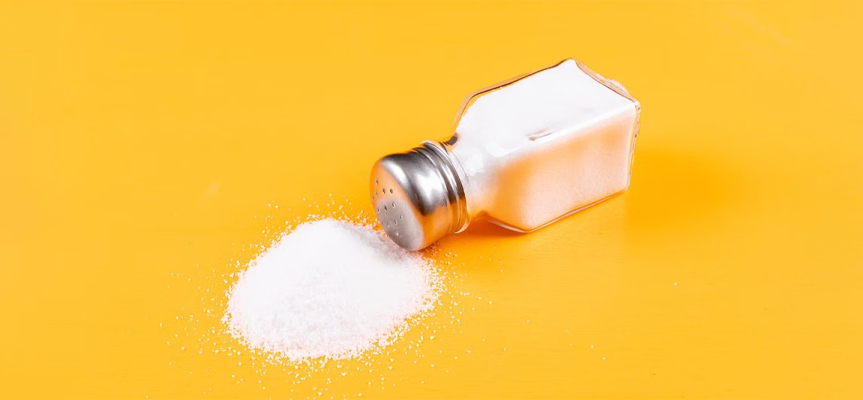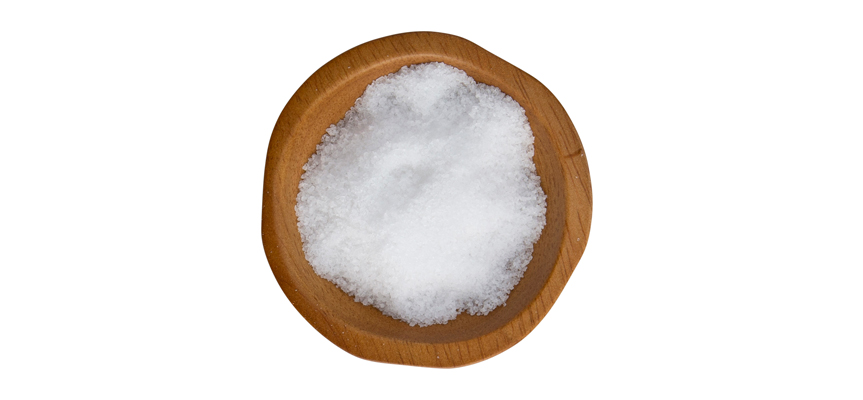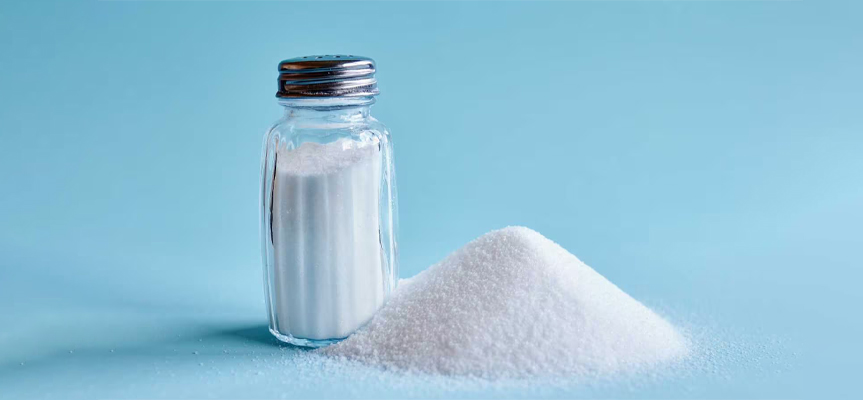Potassium salt, known in chemistry as potassium chloride (KCl), is one of the most widely used alternatives to table salt in recent years, attracting significant attention from nutritionists, doctors, and even the food industry. The reason for this interest lies in its key role in reducing sodium intake, helping to control blood pressure, and promoting healthy eating.
Unlike regular salt, which consists mainly of sodium chloride, potassium salt contains a substantial amount of potassium — an element essential for human health, yet often consumed in insufficient amounts.
This compound is not only suitable for people with high blood pressure but also for those seeking a low-sodium diet and a healthier lifestyle. In the following sections, we will examine the scientific details, culinary uses, and important points regarding the purchase, consumption, and limitations of potassium salt, to fully answer common questions such as “What is potassium salt and what are its benefits?” or “What is the difference between potassium salt and regular salt?”
Chemical Structure and Composition of Potassium Salt
Potassium salt, chemically known as potassium chloride (KCl), is an ionic compound consisting of two main elements: potassium (K) and chlorine (Cl). In appearance, it closely resembles table salt (sodium chloride, NaCl) and is usually found in the form of white or colorless crystals.
Its chemical properties give it a salty taste similar to table salt but with a slight bitterness, which may be more or less noticeable depending on its purity and production method.
Physically, potassium chloride has a melting point of about 770°C and a boiling point above 1400°C. It dissolves well in water, producing a solution with high electrical conductivity.
In the food industry, potassium salt is often obtained from mineral sources such as sylvite or produced through industrial processes. It serves as a rich source of potassium and affects blood pressure and heart function differently from sodium.
Differences Between Potassium Salt and Regular Salt
One of the most interesting aspects for consumers is comparing potassium salt with regular table salt:
- Chemical Composition: Table salt is sodium chloride; potassium salt is potassium chloride.
- Effect on Blood Pressure: High sodium intake is directly linked to increased blood pressure, whereas potassium can help reduce blood pressure.
- Taste: Potassium salt is slightly more bitter, though this is less noticeable when mixed with food.
- Effect on Heart Health: Adequate potassium intake can reduce the risk of stroke and heart disease.
Read more: Why Should We Use Low-Sodium Salt?
Benefits of Potassium for the Body
Potassium is an essential mineral for the proper functioning of the body. It plays a key role in fluid balance, muscle function, and regulating heartbeat. Its benefits include:
- Regulating Blood Pressure: Helps remove excess sodium through urine, lowering blood pressure.
- Supporting Heart Function: Adequate potassium levels reduce the risk of arrhythmias and heart attacks.
- Muscle and Nerve Health: Involved in nerve signal transmission and muscle contraction; deficiency can cause muscle cramps.
- Stroke Prevention: Diets high in potassium are linked to reduced stroke risk.
- Improving Bone Density: Helps maintain acid–base balance, which can prevent osteoporosis.
What Is Potassium Salt and What Are Its Benefits?
Potassium salt is a low-sodium alternative to table salt, containing more potassium instead of sodium. Its benefits include:
- Reducing sodium intake and preventing high blood pressure
- Providing part of the daily potassium requirement
- Supporting heart and vascular health
- Suitable for low-sodium diets
Uses of Potassium Salt in the Diet
Potassium salt is most suitable for people who:
- Have high blood pressure
- Need to limit sodium intake
- Want a healthy, balanced diet
It can be used in cooking, salads, and even processed foods.
Effect of Potassium Salt on Blood Pressure and Heart Health
Research shows that replacing part of sodium with potassium can help reduce blood pressure. This effect is especially notable in people with high blood pressure or those genetically sensitive to sodium. Potassium also has a protective role against blood vessel damage and supports heart health.
Side Effects and Limitations of Potassium Salt Consumption
Although potassium is essential for health, excessive consumption of potassium salt can be dangerous for certain individuals. Those with kidney problems or who are taking specific medications — such as ACE inhibitors or potassium-sparing diuretics — should be cautious.
Possible side effects of overconsumption include:
- Hyperkalemia (excessive potassium in the blood), which can cause heart arrhythmias
- Gastrointestinal issues such as nausea and diarrhea
- Negative effects on kidney function in vulnerable individuals
Price Differences and Buying Tips for Genuine Potassium Salt
The price of edible potassium salt varies based on purity, brand, and packaging size. Products with high purity, standard packaging, and from reputable brands are recommended.
Grownida, as a recognized name in food innovation, holds a special place in producing healthy and safe dietary alternatives.
Other Alternatives to Table Salt
Besides potassium salt, other options to reduce sodium intake include:
- Low-sodium mixed salt (a blend of sodium chloride and potassium chloride)
- Aromatic spices and herbs such as thyme, rosemary, turmeric, garlic, and dried onion
- Natural acids like lemon juice or vinegar for flavor enhancement
Using Potassium Salt in Cooking
Potassium salt can be used in cooking just like regular salt, but it’s best to replace it gradually so the family’s taste adapts. Suitable for:
- Soups and stews
- Grilled and barbecued dishes
- Salads and sauces
- Bread and baked goods
Potassium Salt for Diabetic Diets and Healthy Eating
For people with diabetes, blood pressure control is especially important. Using potassium salt can help by lowering sodium intake and supporting blood pressure balance.
Additionally, potassium plays a role in regulating blood sugar levels and improving insulin sensitivity — both important for diabetes management.
The Role of Potassium Salt in the Food Industry
Today, many companies, including the Grownida Center for Innovation and Creativity, are working on new formulations to reduce sodium in food products. Combining potassium chloride with other additives helps preserve flavor while improving nutritional value.
Potassium Chloride for Sodium Reduction in Processed Foods
Potassium chloride not only reduces sodium content but also helps extend shelf life and maintain quality in certain processed products.
The Future of Salt Alternatives in the Global Market
With growing public awareness of the harms of excessive sodium intake, the market for salt alternatives has expanded significantly. In the coming years, it is expected that:
- The use of potassium salt and low-sodium salts in the food industry will increase
- More research will be conducted to improve their taste
- New combinations of various minerals will be introduced to the market
Conclusion
Potassium salt, as a healthier alternative to table salt, can help reduce blood pressure and improve cardiovascular health. However, its use should be tailored to individual health conditions and monitored by a specialist.
The outlook for this product in the global market is promising, and with the growing demand for healthy eating, it is likely to secure a special place in family diets.
Frequently Asked Questions
What is potassium salt?
Potassium salt, or potassium chloride, is a low-sodium alternative to table salt that helps lower blood pressure and improve health.
Is potassium salt good for blood pressure?
Yes, especially in people whose high sodium intake increases their blood pressure; replacing some sodium with potassium is effective.
What is the difference between potassium salt and regular salt?
Regular salt contains sodium chloride, while potassium salt is made of potassium chloride and has different effects on blood pressure.
Is potassium salt suitable for everyone?
No. People with kidney disease or high potassium levels should consume it with caution.
How can I use potassium salt in my diet?
It can be used instead of regular salt in cooking or on food, but consumption should be kept in check.



